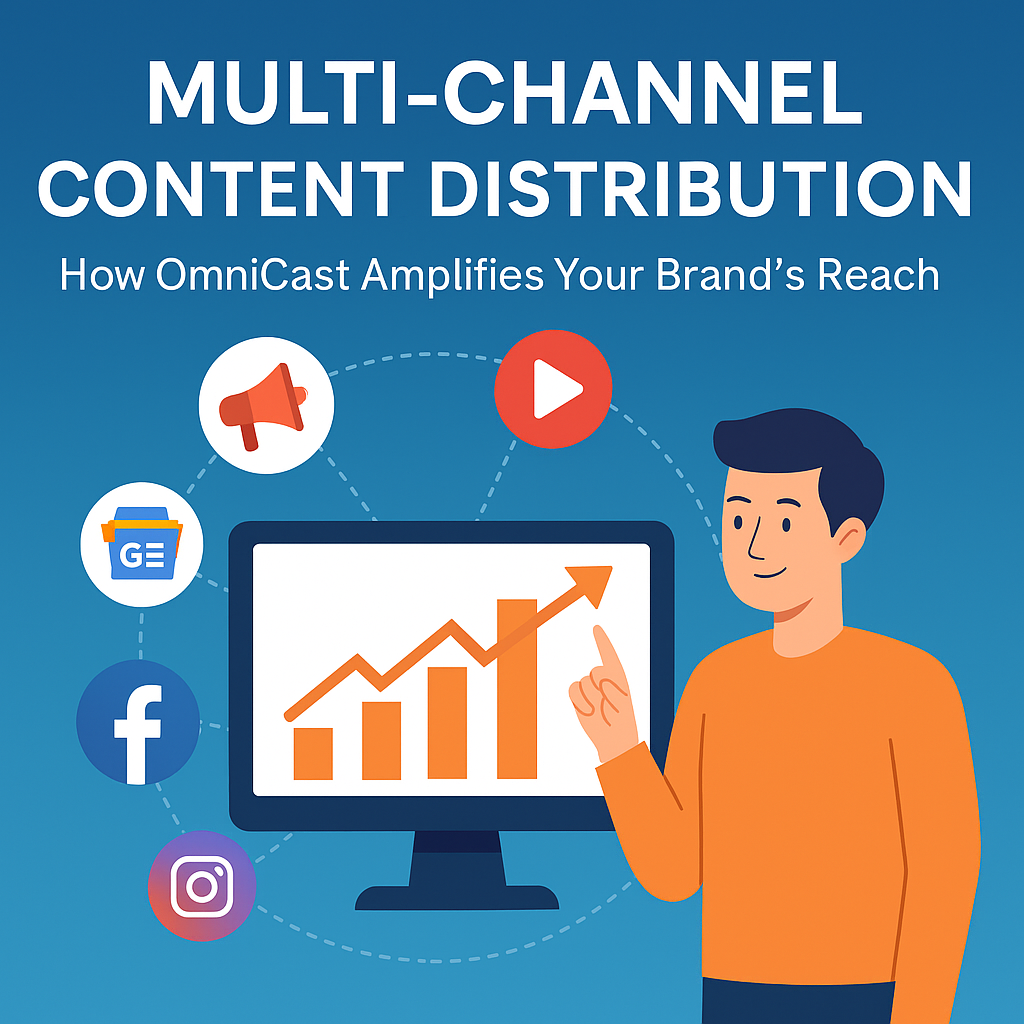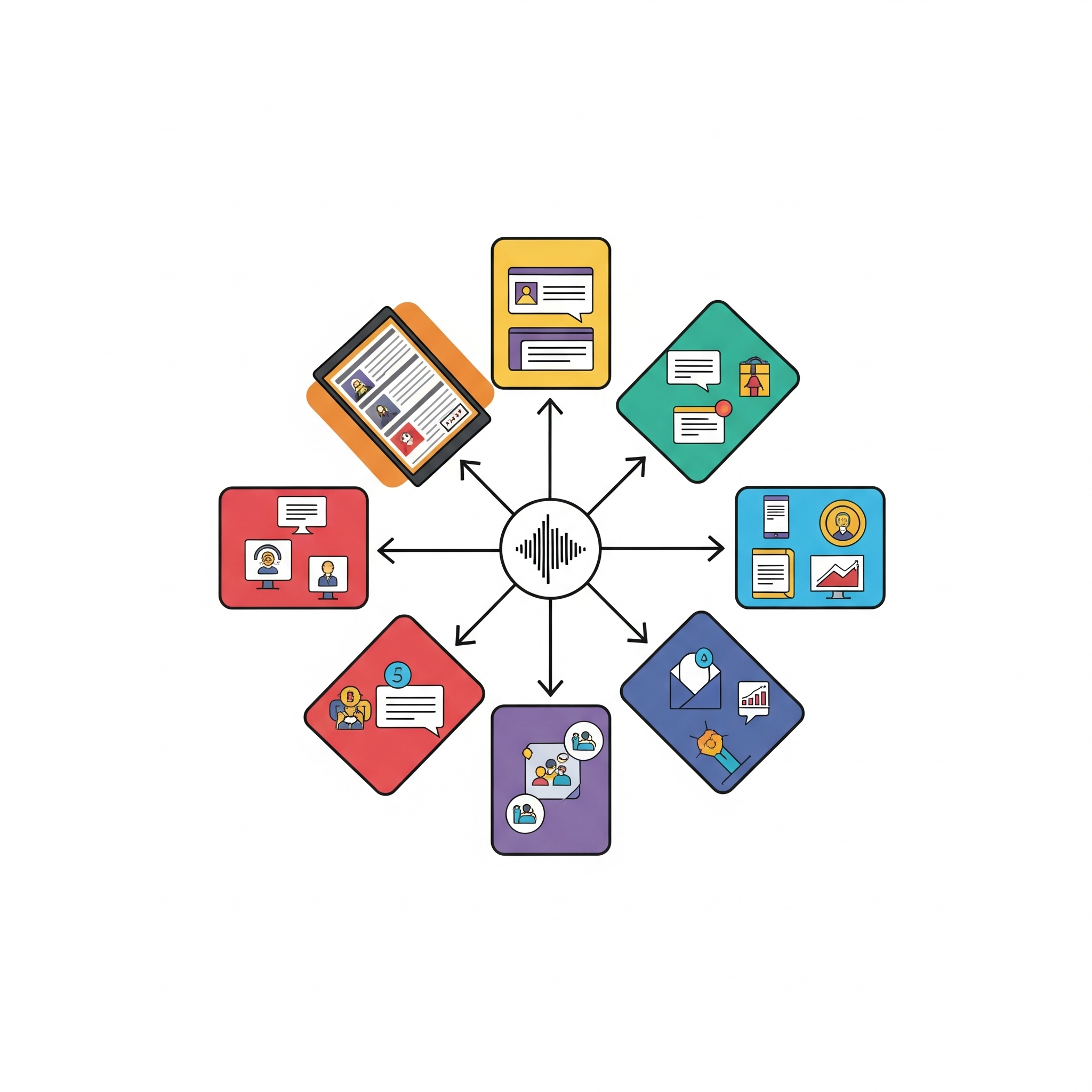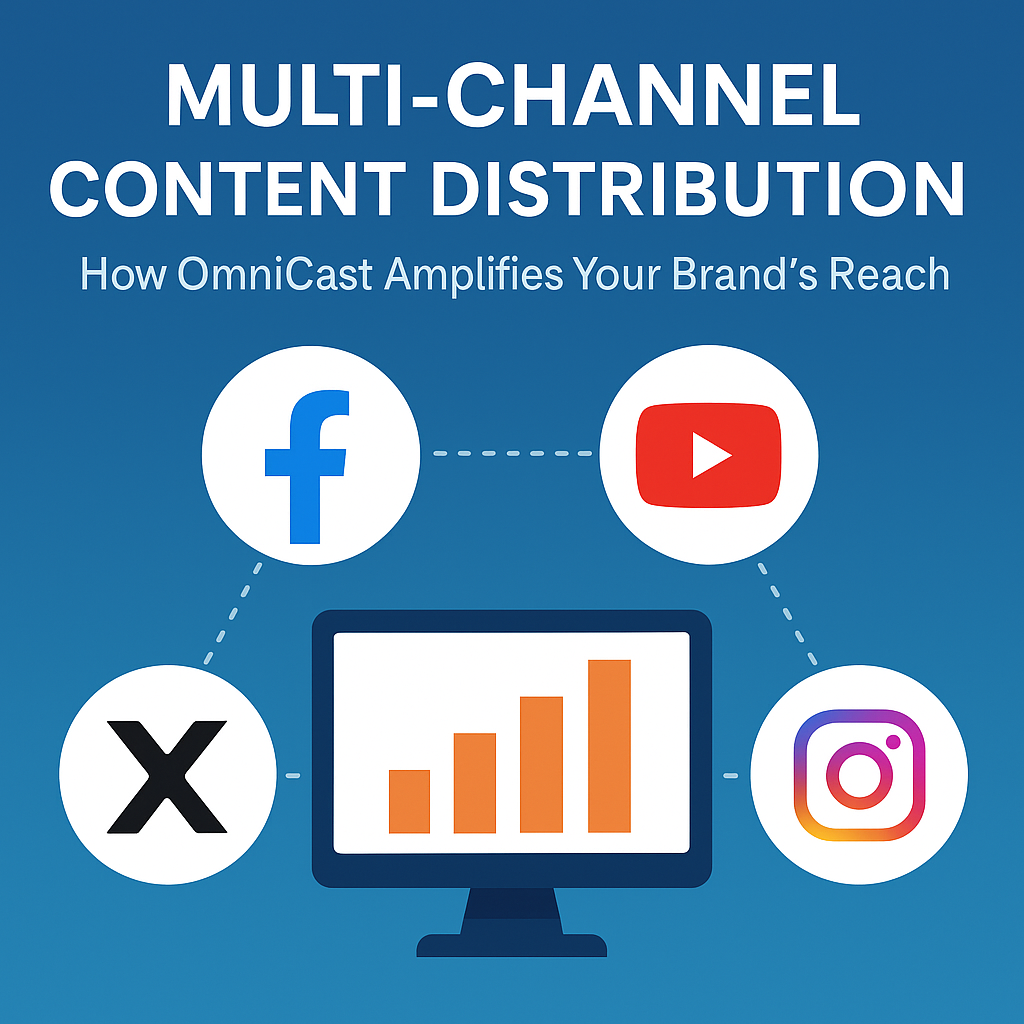Overview
- Multi-channel content distribution increases brand visibility by transforming a single piece of content into multiple formats across various platforms where your audience already spends time.
- Traditional single-channel marketing is becoming less effective in today’s fragmented attention economy, with brands experiencing a decrease in organic reach due to changes in algorithms.
- LeafWorldMedia’s OmniCast platform offers a done-for-you content distribution service across 300+ Google News sites, podcasts, video platforms, and more, eliminating the need for multiple tools or teams.
- Implementing a multi-channel distribution strategy offers 7 key benefits, including increased visibility, improved SEO, greater trust, and access to previously untapped audience segments.
- Companies that use platforms like OmniCast experience faster SEO growth, increased branded search volume, and significantly higher ROI compared to traditional content marketing methods.
The digital landscape is so saturated that even high-quality content often goes unnoticed. Your audience is spread across dozens of platforms, each with its own preferred formats and consumption habits. Despite creating valuable content, many businesses struggle to achieve the visibility and engagement necessary for significant ROI.
The Distribution Dilemma That’s Eating Away at Your Marketing ROI
While content creation can be resource-intensive, it’s the distribution that often proves to be the weak link in many marketing strategies. Recent research suggests that businesses spend as much as 80% of their content marketing budget on creation, leaving a meager 20% for distribution. This disproportionate allocation creates a critical disconnect where valuable content doesn’t make it to its target audience. LeafWorldMedia’s OmniCast platform is designed to tackle this very issue, revolutionizing the way brands distribute content across multiple channels at once.
Let’s face it, content that isn’t strategically distributed might as well be invisible. With over 4.4 million blog posts being published every single day, your content needs to be more than just good quality—it needs to be everywhere. When your content is seen across multiple trusted platforms and in various formats, it gives off an air of authority that just can’t be matched by single-channel approaches.
What Does Multi-Channel Content Distribution Mean?

Multi-channel content distribution is a strategic method that involves adjusting and sharing content on a variety of platforms and formats to increase reach and engagement. This is different from traditional methods that only focus on one channel (such as a company blog). Multi-channel distribution changes one main message into many different content formats like articles, videos, podcasts, and infographics and shares them on relevant platforms where your target audience is already spending their time.
This strategy guarantees that your message gets to your audience, no matter how they like to consume content. Instead of hoping your audience will find you, multi-channel distribution delivers your content to them in the way they like best.
The Magic of OmniCast and AmpCast in Transforming Single Content Pieces
Platforms such as OmniCast have the ability to take your main message and convert it into various content formats, each one tailored for specific distribution channels. One article can be turned into a video script, podcast episode, infographic, and social media content, all distributed to the appropriate platforms with minimal effort from your team. This process of transforming content significantly increases your reach while keeping the messaging consistent across all points of contact.
First, the technology studies your main content, picks out the main message points, and then transforms these points into assets that are specific to each format. For instance, OmniCast’s team may convert a technical whitepaper into a video that’s easy to understand, an in-depth podcast interview, and several news articles. Each of these will emphasize different parts of your message to attract different audience segments.
The Digital Landscape: The Home for Your Content
The current digital landscape is scattered over numerous platforms, each having its unique audience demographics and content preferences. Your potential customers might begin their day by checking their emails, go through LinkedIn while sipping their morning coffee, listen to podcasts during their commute, watch YouTube videos during lunch, and browse Instagram before going to bed. Multi-channel distribution makes sure your brand is visible throughout this entire journey.
With OmniCast, your content can be distributed to over 300 Google News sites, a variety of video platforms, podcast directories, and social media channels. This vast network means your content can show up in search results, news feeds, recommendation engines, and discovery tools all over the web. This gives you several opportunities to reach your target audience throughout the day.
“The average person consumes content across 6.5 different platforms daily. Brands that appear across multiple channels experience 3x higher engagement rates and 90% higher customer retention compared to single-channel marketers.” — Digital Marketing Institute
Why Traditional Single-Channel Marketing No Longer Works
The days when businesses could rely on a single marketing channel are long gone. Consumer attention is increasingly fragmented, with the average person splitting their online time between multiple platforms and devices. This shift has fundamentally changed how content must be distributed to remain effective.
The Divided Attention of Today’s Consumers
Modern consumers are spreading their attention across a variety of platforms, with the average person dedicating more than 7 hours a day to consuming digital content. This division means that your audience is splitting their attention between social media, news websites, video platforms, podcasts, and many other channels. If you only focus on one channel, you’re basically invisible to large parts of your potential audience who simply don’t use that platform.
By having your content appear on all the platforms your audience uses, multi-channel distribution solves this problem. Instead of hoping they’ll stumble upon your company blog or YouTube channel, your message will reach them while they’re already consuming content on a variety of platforms.
How Changes in Platform Algorithms Can Decrease Organic Reach
Both social media platforms and search engines are constantly updating their algorithms, often prioritizing certain types of content while reducing the organic reach of brands. For instance, Facebook’s organic reach for business pages is now less than 5%, and Google’s search results have become more competitive than ever. This means that if you rely on a single distribution channel, your content visibility is at the mercy of platform policies that you have no control over.
Platforms like OmniCast allow you to spread your brand across multiple channels, creating algorithm resilience. If changes affect one platform, your brand is still visible on others, guaranteeing a consistent brand presence regardless of individual platform policies.
Customers Want Brands to Be Everywhere
Today’s customers expect reputable brands to be active on multiple platforms. When they’re researching products or services, they usually look at 3-5 sources before they decide what to buy. Brands that show up across these different touchpoints are a lot more trustworthy than brands that don’t have a lot of visibility. Being on multiple channels makes your brand seem like it’s everywhere, which makes it look like your brand is a big player in your industry.
The illusion of being everywhere greatly affects how much consumers trust a brand. When potential customers see your brand on news sites, videos, podcasts, and social media, it gives them the impression that you are a leader in your industry. This impression significantly influences their decision to purchase.
7 Major Advantages of Multi-Channel Distribution
Adopting a solid multi-channel content distribution plan brings a variety of benefits that single-channel methods can’t compete with. From increased exposure to cost-effectiveness, these advantages together improve marketing results in all important areas.
1. Significantly Boosted Brand Awareness
The most noticeable advantage of multi-channel distribution is the significant increase in brand awareness. Instead of being limited to one platform, your content can now reach audiences through a variety of touchpoints during their day. This continuous exposure creates a sense of familiarity that greatly enhances brand recall and recognition.
Companies using OmniCast usually find their content being shared on hundreds of websites at once. This kind of exposure is not achievable through manual methods. This broad distribution creates a feeling of brand omnipresence, which greatly improves credibility with target audiences.
2. Boosted SEO Authority Via Varied Backlinks
Having your content show up on a variety of high-authority platforms creates quality backlinks that significantly enhance your website’s SEO. These varied backlinks tell search engines that your content is worth something and can be trusted, which in turn increases your domain authority and organic search rankings.
OmniCast’s distribution network spans hundreds of Google News sites and industry-specific platforms, providing contextually relevant backlinks. This diverse backlink profile helps your website rank for competitive keywords and builds long-term SEO resilience that isn’t easily disrupted by algorithmic changes.
3. Increased Trust and Conversion Rates
When prospective customers see your brand on several respected platforms, it creates a strong social proof effect. This repeated exposure fosters familiarity and trust, which significantly influences conversion rates throughout your marketing funnel. Studies have found that consumers who see a brand on multiple channels are 90% more likely to make a purchase than those who only see it on one platform.
By using multi-channel distribution, your message can reach potential customers from all directions at once, creating a “surround sound” effect. This simultaneous convergence of touchpoints speeds up the trust-building process, shortening sales cycles and improving conversion efficiency at every stage.
4. Reaching New Audiences
Each platform has its own unique audience, with their own content preferences and consumption habits. By distributing across multiple channels, you can reach audiences that you would never reach with a single-channel approach. This allows you to introduce your brand to entirely new potential customers, without having to create any additional content.
Surprising audience insights are often unveiled by OmniCast’s platform analytics, with clients discovering unexpected appeal in demographic segments they hadn’t previously targeted. These insights often unlock new market opportunities that have the potential to significantly boost business growth.
5. Uniform Brand Messaging Across Different Platforms
Multi-channel distribution platforms make certain that your primary message stays consistent and is correctly formatted for each platform’s specifications. This consistency helps in building brand recognition and prevents the fragmented messaging that frequently happens when different team members handle different channels independently. For tips on maintaining this consistency, consider these strategies to repurpose content effectively.
OmniCast’s content adaptation process keeps your main message points intact while tweaking them to fit the specific formats of different platforms. This method guarantees that audiences get a consistent brand experience no matter where they come across your content, bolstering overall brand identity and recognition.
6. Detailed Performance Analysis
Multi-channel distribution provides a wealth of performance data from across all platforms, showing which messages, formats, and channels have the most impact on audiences. This information can be used to fine-tune your content strategy, based on real engagement figures rather than guesswork, establishing a strong feedback loop that enhances the success of your marketing efforts over time.
7. Maximizing Content at a Lower Cost
One of the most attractive advantages of multi-channel distribution is its impressive cost-effectiveness. By converting a single piece of content into various formats and sharing them on different platforms, you significantly boost the return on investment of your content. This strategy squeezes the most value out of current content assets without necessitating proportional increases in production budgets. For more insights on how to effectively repurpose content, check out our guide on repurposing blog posts.
Understanding OmniCast: Its Functionality
OmniCast’s platform utilizes advanced content transformation technology in combination with vast distribution networks to increase the reach of your message throughout the digital world. The system employs a smooth four-stage process that takes care of everything from the development of the initial strategy to performance analytics and optimization.
How Content is Transformed
OmniCast’s team starts with your main message or existing content. They then analyze it to find the main points and see where they can adapt the format. Content specialists then take this material and transform it into assets that are specific to different formats. Each of these assets is optimized for different distribution channels. This transformation process usually results in 6-10 different content formats from one source piece. These formats can include news articles, videos, podcasts, infographics, and social media snippets.
300+ Google News Sites and More: The Distribution Network
After the various content assets are created, they are distributed across OmniCast’s vast network of over 300 Google News sites, podcast directories, video platforms, influencer feeds, and industry-specific niche sites. This distribution occurs all at once, resulting in a sudden surge of visibility across multiple platforms. The network includes both general interest sites and industry-specific platforms, ensuring that your content is seen by a wide audience and targeted segments within your specific market.
Performance Monitoring and Analytics Interface
As your content is being distributed, OmniCast’s analytics interface keeps tabs on performance indicators across all channels, giving you an instant snapshot of how your audience is engaging with your content. This all-encompassing monitoring includes counts of impressions, engagement percentages, click-through performance, and conversion attribution details that pinpoint exactly which distribution channels are generating the most meaningful audience interactions.
Our system will automatically pinpoint your best performing content and channels, which allows for ongoing improvement of your distribution strategy. This approach, backed by data, guarantees your content will consistently reach the most receptive audience segments on their favorite platforms and formats.
Deciding Between OmniCast and AmpCast: Which Platform is Right for You?

OmniCast and AmpCast both provide robust multi-channel distribution capabilities, but they do so in unique ways that may be more beneficial for certain organizations. Knowing these differences can help you decide which platform will best meet your marketing goals and team needs.
Comparing Key Features
| Feature | OmniCast | AmpCast |
|---|---|---|
| Service Model | Fully managed (we do it for you) | Do it yourself with support options |
| Distribution Network | 300+ Google News sites, podcasts, video platforms | 300+ news sites, podcasts, video channels |
| Content Formats | Articles, videos, podcasts, infographics, slideshows | Articles, videos, podcasts, press releases |
| Analytics Depth | Comprehensive with attribution tracking | Basic performance metrics |
| Customization Level | High (industry-specific distribution) | Moderate (category-based targeting) |
Setup Requirements and How Long It Takes
OmniCast is a fully managed service that requires very little from you beyond the initial strategy development. We typically start the implementation 3-5 business days after onboarding, and the first distribution campaign is usually launched within two weeks. This hands-off approach makes OmniCast perfect for businesses that don’t have the internal resources to manage content distribution or prefer to focus their team’s efforts elsewhere. For more insights on how to get your business featured on Google News, consider exploring additional resources.
With AmpCast, you have more of a do-it-yourself model, though support options are available. This means you’ll need to be more involved in setting up and managing the platform. While this gives you more direct control, it also means you’ll need to dedicate resources to managing the platform effectively. The time it takes to get up and running varies, but generally, you can expect it to take 1-3 weeks, depending on how quickly you complete the necessary steps.
Pricing and Return on Investment
OmniCast’s pricing structure is a reflection of its all-inclusive managed service model. Packages typically start at $3,000 to $5,000 per month for full-service distribution. While this may seem like a significant initial investment, it eliminates the need for additional staff or tools to manage distribution. Return on investment analyses have shown that clients typically see positive returns within 3 to 4 months. This is due to the combined benefits of increased visibility, lead generation, and SEO improvements.
With self-service options starting at around $1,500-2,500 per month, AmpCast provides more accessible entry points. However, the internal resources needed to manage the platform effectively must be considered alongside these costs. When staff time is factored in, many companies find that the total cost difference is significantly reduced, and OmniCast’s managed approach often yields quicker results because it is optimized by experienced distribution specialists.
Success Stories
Multi-channel distribution’s transformative power is best understood through real-world examples. A medium-sized SaaS company was having trouble generating leads despite creating top-notch content. They decided to give OmniCast’s distribution strategy a try, and the results they saw in just 90 days were astounding. Their branded search volume shot up by 142%, organic traffic increased by 87%, and their lead conversion rates went up by 53% – and they didn’t have to create any additional content to achieve these results.
Another example is a professional services company that leveraged multi-channel distribution to position themselves as thought leaders in a highly competitive market. They converted their quarterly industry reports into a variety of content formats and distributed them across OmniCast’s network. This strategy resulted in securing speaking engagements at key industry conferences, attracting interview requests from business publications, and ultimately expanding their client base by 38% in just six months.
A local healthcare provider used multi-channel distribution to combat negative press coverage after a single incident. By sharing positive patient outcome stories and community involvement initiatives on various platforms, they were able to successfully change the narrative about their brand. Within four months, positive sentiment metrics had increased by 73%, and new patient inquiries had increased by 29% compared to the levels before the crisis.
Getting Started with Multi-Channel Distribution Today
Switching to a multi-channel distribution model requires careful planning and a methodical approach. The first step is to thoroughly review your existing content assets and distribution channels, and then create a detailed strategy that covers all platforms. With the right planning and tools, most businesses can start using effective multi-channel distribution within 4-8 weeks.
The secret to effective execution is to keep the message consistent while adjusting the content formats to meet the unique requirements of each platform. Instead of just reposting the same content across channels, successful multi-channel distribution modifies your main message to take advantage of the native strengths and audience expectations of each platform.
Review Your Existing Content
Start by thoroughly examining your current content, pinpointing those that have the potential to perform well if repurposed in various formats. Look for key content that discusses essential industry issues, shows unique expertise, or offers unique value to your audience. These high-value content will be the basis for your first multi-channel campaigns, providing the quickest return on your distribution investment.
Plan Your Cross-Platform Strategy
Design a strategic distribution plan that pairs content types with suitable platforms based on audience demographics and consumption preferences. This plan should identify the main and secondary distribution channels for each content piece. It should also establish consistent brand messaging guidelines that ensure a coherent presentation across all platforms. For businesses looking to enhance their advertising efforts, consider these best Facebook and Google Ads tips to effectively reach your audience.
A successful multi-platform strategy strikes a balance between a wide reach and focused precision. It uses platforms with a broad user base to increase brand awareness, while also using niche-specific channels to engage with valuable audience segments. This multi-layered approach enhances both visibility and relevance, providing multiple opportunities for audience engagement at every stage of the customer journey.
Choosing the Appropriate Distribution Tools and Partners
It’s important to assess potential distribution platforms by considering your unique business needs, target audience, and the resources you have available internally. Factors to take into account include the reach of the network, capabilities of the format, relevance to the industry, depth of the analytics, and requirements for implementation. For most businesses, the decision to use managed services like OmniCast or self-service platforms like AmpCast will largely be based on the resources they have available internally and how quickly they want to see results.
Tracking Success: Key Performance Indicators
Before you start your multi-channel distribution strategy, set up performance metrics that match your business goals. Don’t just look at basic visibility metrics such as impressions and engagement. Monitor downstream indicators like branded search volume, organic traffic growth, lead quality improvements, sales cycle length, and customer acquisition costs. These detailed measurements give you a true picture of how your distribution strategy is affecting your business. They also show you which channels and content formats are performing the best.
Content Distribution Is Heading Everywhere
- AI-powered content adaptation will enable automatic conversion of core messages into dozens of platform-specific formats
- Voice search optimization will become a necessity as the consumption of audio content continues to grow at a rapid pace
- Augmented reality integration will facilitate the creation of immersive multi-sensory content experiences across platforms
- Hyper-personalized distribution will offer custom content variations based on individual audience behavior patterns
- Blockchain verification will confirm content authenticity across distributed platforms
The evolution of multi-channel distribution continues to speed up as technology progresses and consumer behavior becomes increasingly fragmented. Brands that think ahead are already preparing for these changes by constructing flexible distribution frameworks that can swiftly adapt to emerging platforms and formats. Learn how AI-powered content adaptation can revolutionize your strategy.
Top industry professionals predict that the focus of audiences will continue to fragment across a growing range of content platforms. Instead of becoming more consolidated, it’s likely that the digital landscape will become more varied as specialized platforms appear to cater to niche interests and consumption habits. This trend means that strong multi-channel distribution is becoming more and more important for keeping a brand visible and engaging.
Content platforms and distribution tools will integrate effortlessly. AI systems will take charge of optimizing format, timing, and channel selection based on real-time performance data. These smart distribution systems will keep refining their approach through machine learning. This way, every content asset will have maximum impact throughout its lifecycle.
Brands that invest in multi-channel distribution capabilities today will reap the benefits in the future as the digital landscape continues to change. The ability to maintain a consistent presence across various platforms will become an increasingly valuable strategic asset, creating significant barriers to entry for competitors trying to build similar visibility from scratch.
Common Questions
With multi-channel distribution becoming a key player in digital marketing strategies, it’s only natural that marketers have questions about how it works, how effective it is, and how to best implement it. In this section, we’ll cover the most frequently asked questions we get from businesses who are considering using multi-channel distribution platforms like OmniCast.
We’ve gleaned these insights from examining hundreds of successful implementations across a variety of industries and businesses of all sizes. While the specific results can vary based on factors such as how competitive the industry is, the quality of the content, and the objectives of the campaign, these answers give you a good idea of what you can expect to achieve with multi-channel distribution.
What is the impact of multi-channel distribution on SEO performance?
There are several ways in which multi-channel distribution bolsters SEO. Firstly, it generates a variety of high-quality backlinks from respected sites throughout OmniCast’s network of over 300 Google News sites and industry platforms. Secondly, the increased visibility of the brand results in a higher volume of branded searches, which Google views as a signal of trust. Thirdly, content that is present on multiple platforms creates social signals and engagement metrics, which further increase domain authority. When combined, these factors typically result in noticeable improvements in SEO within 60-90 days, with further growth as distribution campaigns build up over time.
What kind of content is most effective on platforms like OmniCast?
Multi-channel distribution campaigns that perform best usually focus on educational, informative content that solves audience problems or fills in gaps in their knowledge. Pieces that show thought leadership, industry analyses, research findings, how-to guides, and expert insights usually do better than content that is overtly promotional. OmniCast’s transformation process can adapt almost any valuable core message, but content that clearly benefits the audience consistently gets the best engagement metrics and conversion rates across distribution channels.
When can I expect to see results from multi-channel distribution?
Most businesses start to see their content appear across multiple platforms within the first 7-14 days. After about 30 days, you should start to see an uptick in engagement metrics. Lead generation and conversion impacts typically start to show within 60-90 days. SEO benefits usually start to show within 2-3 months and continue to improve over time. The more campaigns you run, the more these benefits compound, leading to sustained growth in visibility, engagement, and conversion metrics.
Are multi-channel distribution platforms affordable for small businesses?
Multi-channel distribution was once a luxury only large corporations could afford. However, platforms like OmniCast have made it possible for businesses of all sizes to utilize this strategy. Many small businesses have found that shifting their budget from traditional marketing channels that aren’t performing well to multi-channel distribution actually improves their marketing ROI. It also reduces the amount of time they have to spend managing content distribution. For businesses on a tight budget, starting with quarterly distribution campaigns for cornerstone content pieces often provides the best balance between impact and cost.
Moreover, numerous companies are eligible for packages tailored to their industry or scaled deployments that provide crucial distribution functionalities at more affordable prices. OmniCast provides adaptable deployment options specifically created for expanding companies, empowering them to compete successfully against bigger rivals by leveraging the potential of their existing content assets.
-
Basic packages that concentrate on the main distribution channels
-
Quarterly campaign alternatives for companies with limited content production capabilities
-
Distribution packages that are industry-specific and target high-value vertical platforms
-
Scalable implementation strategies that evolve as your business expands
-
Content transformation services that make the most of existing assets before requiring new creation
For many small businesses, the decision often comes down to how to allocate resources rather than the total cost. By eliminating the need to hire additional staff or manage multiple distribution tools on their own, platforms like OmniCast often offer cost benefits that make comprehensive distribution possible even with modest marketing budgets.
The main thing to think about is how it lines up with your business goals and plans for growth. If your business is focused on being seen more, doing better with SEO, and using content in the most efficient way, using many channels to distribute your content is usually a better investment than creating more content or only using one channel for marketing.
What separates multi-channel distribution from just posting on multiple social media platforms?
Multi-channel distribution is not the same as just posting the same content on different social media platforms. It is a more comprehensive approach that includes adapting your content to fit different formats (like articles, videos, podcasts, etc.), and strategically placing them across a wide range of platforms, including news sites, video platforms, podcast directories, industry publications, and social media platforms. This approach allows you to reach a wider audience, including those who may not see your content on social media.
Moreover, platforms such as OmniCast offer a gateway to high-authority sites that are usually unreachable through direct outreach or social posting. Having your brand placed on these established, trusted platforms offers a much stronger credibility signal and SEO benefits than just sharing on social media. The strategic distribution across interconnected platforms also creates a powerful amplification effect, where being visible on one channel leads to discovery on related platforms.







Leave a Reply